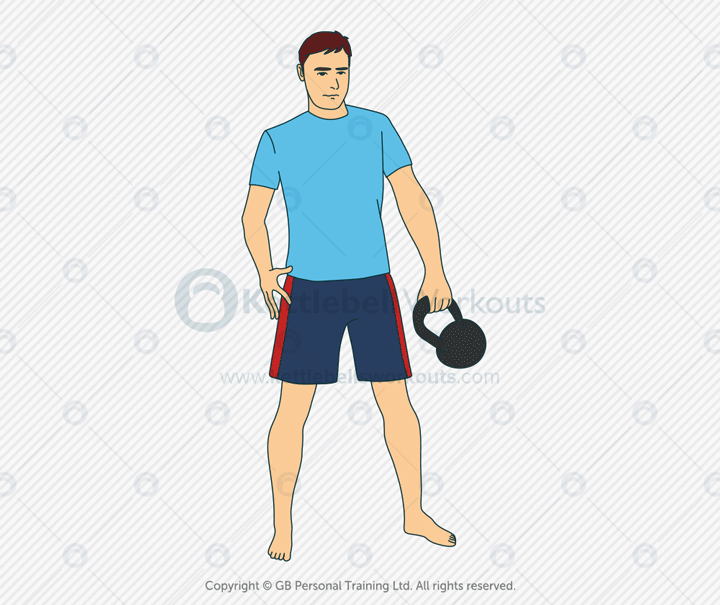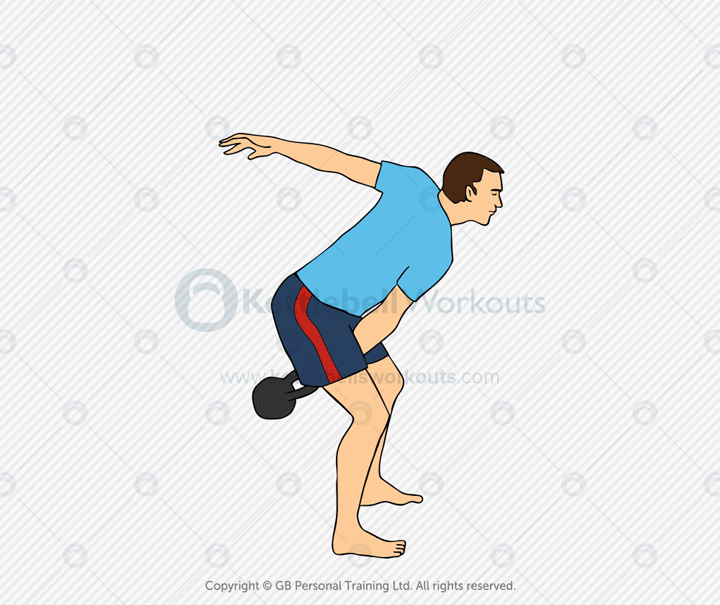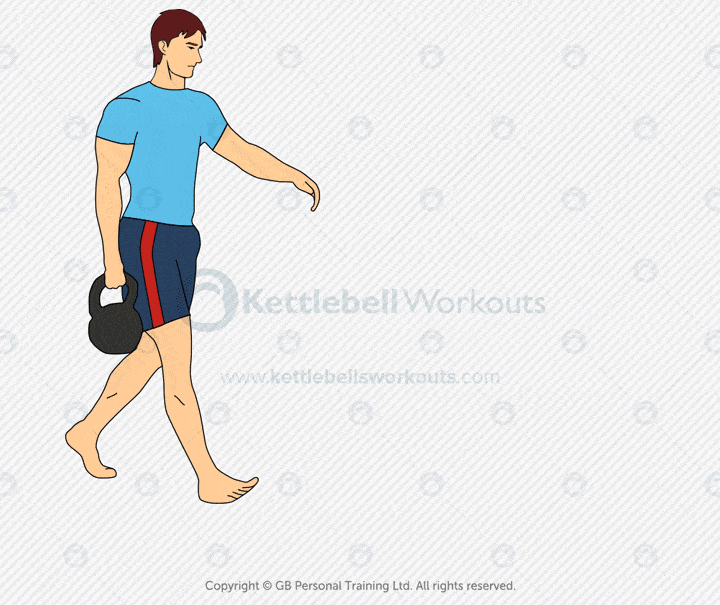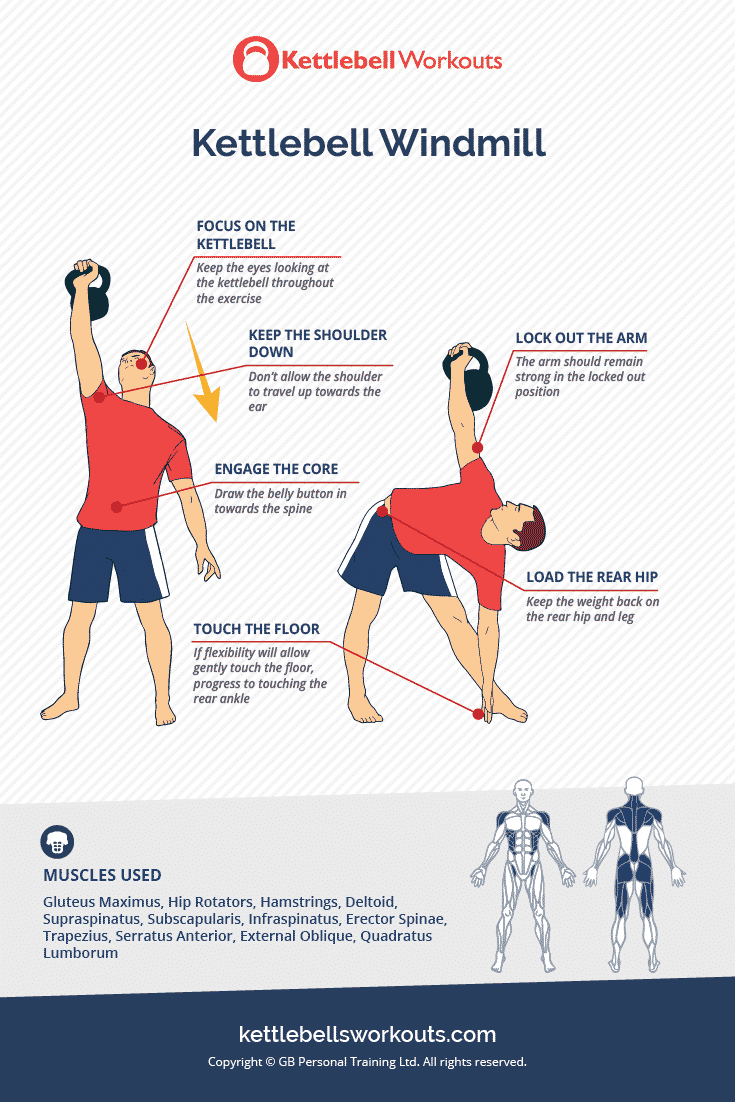Last Updated on 29 July 2025 by Greg Brookes

The single-arm kettlebell swing, also known as the one-arm swing, is the natural evolution of the two-handed swing. It brings a new level of challenge to your training, demanding more from your grip, shoulders, and core, while still delivering the explosive, fat-burning benefits that make the kettlebell swing a staple in strength and conditioning programmes.
If you have already mastered the two-handed swing (read my full guide here), it is time to level up with this powerful progression.
What Is the Single-Arm Kettlebell Swing?
At its core, the single-arm swing follows the same movement pattern as the two-handed swing. It is a ballistic hip hinge powered by glutes and hamstrings, not a squat.
But with only one hand on the bell, your body has to fight rotational forces. This makes it a superior movement for building unilateral strength, core stability, and shoulder integrity.

Muscles Worked
The single-arm swing hits almost every major muscle group. Here’s what is working hardest and why:
- Glutes and hamstrings provide the power behind the swing, driving hip extension.
- Core and obliques brace against the rotational force, stabilising your spine and torso.
- Upper back and scapular stabilisers help control shoulder position and keep the arm in alignment.
- Forearms and grip are taxed throughout, as you hold onto the bell under dynamic load.
It also trains all the smaller stabilisers that prevent the kettlebell from pulling your torso off-line, a demand not present in the two-handed version.
Benefits of the Single-Arm Swing
Why should you include this in your programming? Beyond the basics, this variation adds a range of unique benefits:
- Builds anti-rotational core strength by forcing your torso to resist being pulled sideways.
- Reinforces shoulder stability as your scapular muscles must work harder to maintain position.
- Improves unilateral power and balance, addressing asymmetries.
- Enhances grip endurance, which often limits performance in other lifts.
- Provides more clearance between the legs, making it more accessible for some lifters.
You still get all the cardiovascular, postural, and fat-burning benefits of the regular swing, but with more neurological and muscular challenge.
How to Perform the Single-Arm Kettlebell Swing
Step-by-Step Technique:
- Setup: Place the kettlebell 12 inches in front of you. Feet shoulder-width apart.
- Hinge: Push hips back, keep spine neutral, and grip the kettlebell with one hand.
- Hike: Pull the bell through your legs like a hike pass.
- Snap: Drive hips forward explosively, allowing the bell to float to chest height.
- Control: Let the bell fall naturally and guide it back through your legs.
- Repeat: Maintain posture, rhythm, and core engagement.
Watch a Video of the Kettlebell Single Arm Swing:
Coaching Cues:
These tips will help you fine-tune the movement:
- Keep the free arm relaxed or mirrored to balance rotation.
- Snap hips before the arm rises, do not muscle the bell up.
- Feel the glutes contract at the top and abs brace tight.
Common Mistakes to Avoid
Even seasoned kettlebell users slip into these form errors. Keep an eye on the following:
- Twisting the torso: The bell will try to rotate your body. Resist with your core.
- Shrugging the shoulder: Keep the shoulder packed and scapula engaged.
- Over-gripping: Your hand should guide the bell, not choke it.
- Squatting the swing: Hinge, do not squat.
Progressions: Building Up to the One-Arm Swing
If jumping into single-arm swings feels like a big leap, follow this smart progression to develop strength and technique:
- Master 60 seconds of two-handed swings to build hip drive endurance.
- Do 10 reps per arm. Repeat for 3 rounds to develop unilateral control.
- Work up to 60 seconds per arm for full swing volume.
- Increase kettlebell weight by 4kg. Return to step 1 with the new load.
Sample Workouts
Here are three ways to plug the single-arm swing into your weekly routine:
Workout 1: EMOM Challenge
For conditioning and pacing:
- 10 swings each arm, every minute on the minute
- Duration: 5 to 15 minutes
Workout 2: Swing and Slingshot
To work recovery and flow:
- 30 sec one-arm swing left
- 30 sec kettlebell slingshot
- 30 sec one-arm swing right
- 30 sec kettlebell slingshot
- Repeat 3 to 5 rounds

Workout 3: Ladder Format
For progressive volume:
- 15 sec per arm
- 30 sec per arm
- 45 sec per arm
- 60 sec per arm
- Rest as needed between rounds
Variations
Once you are solid on the basic one-arm swing, explore these movement upgrades:
- Hand-to-hand swings: Change hands mid-air to develop timing and flow.
- Alternating swings: Switch hands each rep for rhythm and coordination.
- High pulls or snatches: Build hip-to-arm transfer for more advanced lifts.

Equipment Tips
Choosing the right kettlebell can make or break your swing. Here’s how to select the right weight:
- Beginners: 8 to 12kg (women), 12 to 16kg (men)
- Intermediate: 16 to 20kg (women), 20 to 24kg (men)
Grip chalk and a smooth-handled bell reduce fatigue and improve safety during high-volume sets.
Coach’s Insight: Greg’s Take
In over a decade of coaching, I have found the single-arm swing to be one of the most revealing kettlebell exercises.
It shows you instantly where your asymmetries, weak links, and movement flaws lie. It is not about how heavy you go, it is how well you manage the rotation, the shoulder, the rhythm.
I often use it in warm-ups to activate the core and in finishers for conditioning. When a client can swing confidently with one arm, I know they have built real control, not just brute strength.
Pro tip: Use your non-working arm as a counterbalance. Some athletes keep it tight to the side, others mirror the swing. It is about what stabilises you best.
Your swing progression continues. Explore all kettlebell swing variations and exercises.
Frequently Asked Questions
Primarily glutes, hamstrings, core, shoulders, and grip. It also recruits the lats and stabilisers to resist rotation.
Two to five times per week is ideal. Start light and focus on control before increasing load.
You can, but the movement feels less natural due to a higher centre of gravity. Kettlebells swing better.
If done correctly, yes. It can actually help strengthen the shoulder stabilisers. But consult a physio if in doubt.




Greg – great video and instruction on how to smoothly change hands with the KB swing. I had been struggling with alternating arms and once you explained the turn of the KB at the top of the swing and I tried it, the change actually became fun!
Hello Greg,
I’m interested in starting kettlebell exercises at home. My issue is that due to a stroke Seven years ago I have weakness on my left side (not a big issue) and my left arm/hand is paralyzed below the elbow (big issue).
If I only ever do exercises with my right hand, will it cause problems or is it just as effective for the core but just doesn’t work out the left arm/shoulder area?
Or is this a too difficult question?
Thanks a lot
Hey Greg I have a bad left shoulder is it ok to do 1 arm kettlebell swings with just the right hand for awhile ?
Sure Mike, does it hurt when you perform two handed swings? Often movements below shoulder height can be OK.
Thank you – clear, detailed demo with great instructions and tips.
Hi Greg. What do you think about the single-arm skier swing?
It would depend on your goals Stefano, is there any particular reason why you want to use that exercise?
Well, it seems to work my back more than any other version. Being a senior, I need a strong back. I’m currently doing 2 back-to-back sets of 15+15 reps with 12 kg.
Tried the one arm swing today for the first time, I can definitely feel it in my shoulders! Thanks for creating the workouts. I did #1 today and am looking forward to doing the others!
Greg,
In your one handed swing video, you showed it from the side view. I would have like a front view as well. At the top of the swing, where is the KB? The arm is straight out but is the KB center chest which means the straight arm is angled in. Or is the arm straight out with the KB aligned with the side of the body?
In week 3 of the 12 week program.
Hi Pat, the arm is chest height and the kettlebell is in the centre of the body and slightly angled in as you mention.
Best of luck with the program.
I’m doing the two handed swing with a 12 kg kettlebell, should I start the one handed swing with a 10kg kettlebell or try right off with a 12 kg?
If you have a 10kg Maria then you can certainly try that first, keep the reps low 5-10 each side. Just ensure that you can swing the 12kg for 60 seconds non-stop before moving onto the single arm.
Thanks for the reply. Yes, I can swing the 12kg two-handed for 60 seconds (about 40 reps). I’m finding with the single arm swing at 12 kg that my hand gets sweaty pretty quickly and my grip starts to slip. Any suggestions there? I’m doing the Women’s training package right now and am on week 3. One more question: I’m also noticing that with the one arm swing, my wrist turns back a little (thumb pointing backwards) versus remaining flat like it does with the two handed swing. Is that just from the extra rotation or should I concentrate on keeping the hand/wrist position the same as for the two-handed swing? Thanks!
Hi Maria, your grip strength will naturally improve and although your hands may get sweaty you will feel more comfortable holding on, just keep practicing but don’t let go 🙂
As for your thumb pointing backwards, yes mine does the same too, I think it is a natural alignment with the shoulder as you take the arm down and back so no need to worry about that.
Keep up with the training.
Oh — by the way — I’ve been doing practice one-legged squats in anticipation of the pistol squats. They won’t be pretty. But I hope by Week 12 they grow closer to becoming a thing of beauty!
Again I say — I’m so glad I found your apps and the rest of your programs. It’s fabulous to be able to travel anywhere with my own gym!
Sounds like you are going along nicely Joanne, those Pistol Squats will really wake you up! All the best.
Good morning Greg — or I guess it’s afternoon! I’m in Week #9 of the 12-week Muscle Building Program. Wonderfully challenging and good practice at managing weight vs repetition and very timely with your newsletter of last week.
I just want to clarify that the swings in Week 9, Day 2 are 30 single arm swings ON EACH SIDE — I assume this is for endurance — x 5 sets. As I look ahead to that particular workout, I’m tired already! 😉
I’ve really enjoyed learning a few new exercises and perfecting them through the weeks. Great program with a lot of thought put into it.
Hi Joanne, the Swings on week 9 are Two Handed Swings x 30 reps rather than One Handed 🙂
Greg, while most people talking about how to do kettlebell swings online seem to be saying that when doing one-arm swings, the arms goes straight in front of your body, some people like Valery Fedorenko believe it is best to have your elbow bent towards the chest somewhat at the top of the swing. He says this makes the kettlebell “fly” better, and it helps prepare people to later on learn to do the snatch. What do you feel about this? Personally, I’ve been doing the one-arm swing as you suggest and demonstrate, but Fedorenko should know — maybe he’s just coming from a different perspective…..
Hi Douglas, good question. The most important and effective part of the swing is the hip drive, this is what most people have trouble with. You are activating the largest muscles in your body, the glutes, along with the whole posterior chain. I tend to teach a straight arm because as soon as you mention a bending of the arm then the beginner starts to “muscle” the kettlebell rather than using their hips. Once you can swing well and effectively from your hips then whether you bend your arm at the top or not is up to you. The most important thing about the arm is keeping the shoulder back and in its socket purely because you don’t want to be putting a passive stretch through your soft tissue when it’s vulnerable.